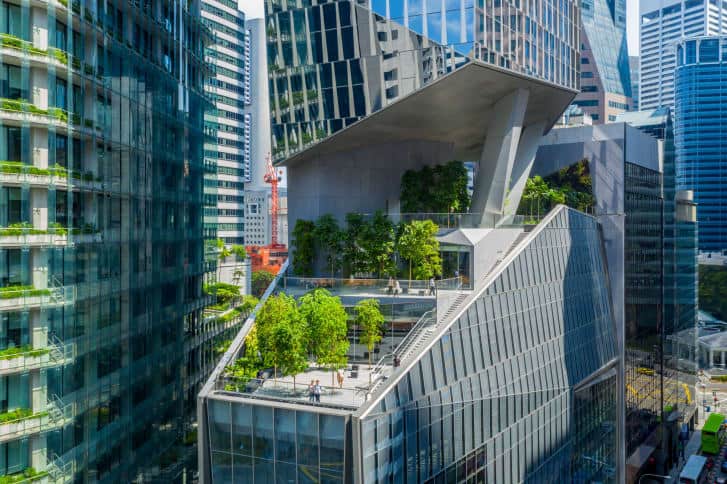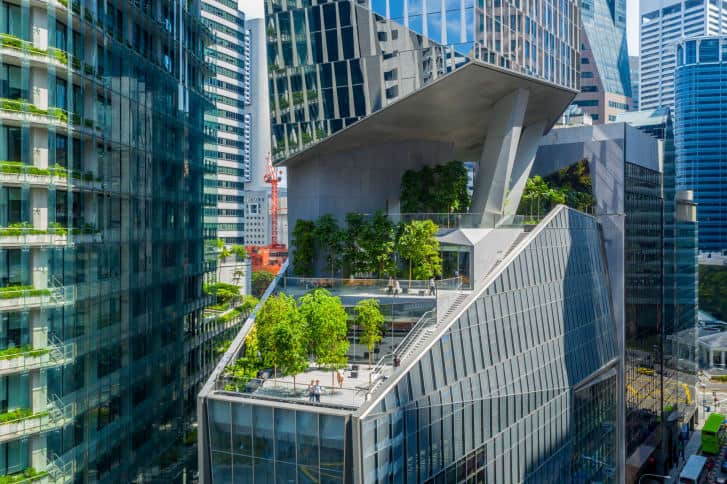The Role Of Sustainable Design In Modern Building Architecture
In recent years, the world has witnessed an increased awareness of the impact of human activities on the environment. As a result, there has been a growing need for sustainable design in modern building architecture to mitigate the negative effects of construction on the environment. Sustainable design is a holistic approach to designing buildings that considers the environmental, social, and economic impacts of construction, operation, and maintenance. In this article, we will explore the role of sustainable design in modern building architecture and its importance in creating a more sustainable future.
The Role of Sustainable Design in Modern Building Architecture
Sustainable design is becoming an increasingly important aspect of modern building architecture. With climate change and environmental concerns at the forefront of global discussions, architects and designers are now looking for ways to create buildings that are not only aesthetically pleasing but also environmentally friendly. In this article, we will explore the role of sustainable design in modern building architecture.
1. What is Sustainable Design?
Sustainable design, also known as green design, is an approach to designing buildings that aims to reduce the negative impact of construction on the environment. This is achieved by using renewable materials, reducing waste, and minimizing energy consumption. Sustainable design also takes into account the health and well-being of occupants, ensuring that buildings are comfortable and healthy places to live and work.
One of the key principles of sustainable design is the use of renewable materials, such as bamboo, reclaimed wood, and recycled plastic. These materials are not only environmentally friendly but also offer unique aesthetic qualities that can enhance the design of a building. In addition, sustainable design often incorporates features such as green roofs, rainwater harvesting systems, and solar panels, which help to reduce the environmental impact of buildings.
2. Benefits of Sustainable Design
Sustainable design offers a range of benefits, both environmental and economic. By reducing energy consumption and using renewable materials, buildings can significantly reduce their carbon footprint and contribute to a more sustainable future. In addition, sustainable buildings often have lower operating costs, as they require less energy and maintenance than traditional buildings.
Sustainable design can also have a positive impact on the health and well-being of occupants. Buildings designed with sustainability in mind often have better indoor air quality and natural lighting, which can improve productivity and reduce the risk of health issues such as respiratory problems.
3. Sustainable Design vs Traditional Design
Traditional building design often prioritizes aesthetics over sustainability, resulting in buildings that are not as environmentally friendly as they could be. Sustainable design, on the other hand, prioritizes both aesthetics and sustainability, resulting in buildings that are not only visually appealing but also environmentally responsible.
In terms of cost, sustainable design can sometimes be more expensive upfront, as it often involves the use of more expensive materials and technologies. However, over the long term, sustainable buildings can be more cost-effective, as they require less energy and maintenance than traditional buildings.
4. Sustainable Design and Energy Efficiency
One of the key aspects of sustainable design is energy efficiency. Sustainable buildings are designed to reduce energy consumption and minimize the use of non-renewable resources. This is achieved through a range of features, including passive solar design, energy-efficient appliances, and the use of renewable energy sources such as solar and wind power.
Passive solar design involves orienting a building to maximize the amount of sunlight it receives, while minimizing heat loss. This can be achieved through the use of windows, shading devices, and insulation. Energy-efficient appliances, such as LED lighting and low-flow water fixtures, can also significantly reduce energy consumption.
5. Sustainable Design and Water Conservation
Water conservation is another important aspect of sustainable design. Sustainable buildings often incorporate features such as rainwater harvesting systems, which collect rainwater for use in irrigation and toilet flushing. Low-flow water fixtures and efficient irrigation systems can also help to reduce water consumption.
In addition, sustainable design can also help to reduce water pollution, by incorporating features such as green roofs and permeable paving, which allow rainwater to be absorbed into the ground rather than running off into storm drains.
6. Sustainable Design and Materials
The use of sustainable materials is a key aspect of sustainable design. Sustainable materials are those that are renewable, recycled, or have a low environmental impact. Examples of sustainable materials include bamboo, cork, recycled plastic, and reclaimed wood.
Using sustainable materials not only reduces the environmental impact of buildings but can also add unique aesthetic qualities to a building’s design. In addition, sustainable materials often have a longer lifespan than traditional materials, reducing the need for frequent replacement and reducing waste.
7. Sustainable Design and Indoor Air Quality
Indoor air quality is an important consideration in sustainable design. Sustainable buildings are designed to maximize natural ventilation and reduce the use of synthetic materials, which can release harmful chemicals into the air.
Features such as operable windows, natural ventilation systems, and the use of low-VOC (volatile organic compound) materials can significantly improve indoor air quality. This can have a positive impact on the health and well-being of occupants, reducing the risk of respiratory problems and other health issues.
8. Sustainable Design and Building Performance
Building performance is a key aspect of sustainable design. Sustainable buildings are designed to perform well in a range of areas, including energy efficiency, water conservation, and indoor air quality. This is achieved through the use of sustainable materials, energy-efficient systems, and passive solar design.
In addition, sustainable buildings often incorporate features such as green roofs and permeable paving, which help to reduce the environmental impact of construction and improve building performance over the long term.
9. Sustainable Design and Community
Sustainable design can also have a positive impact on the community. Sustainable buildings often incorporate features such as community gardens and public spaces, which can improve the quality of life for residents and promote social interaction.
In addition, sustainable buildings can also have a positive economic impact on the community, by creating jobs in sustainable industries and reducing the cost of living for residents through lower operating costs.
10. Conclusion
In conclusion, sustainable design is an important aspect of modern building architecture. By prioritizing both aesthetics and sustainability, architects and designers can create buildings that are not only visually appealing but also environmentally responsible. Sustainable design offers a range of benefits, including lower operating costs, improved indoor air quality, and reduced environmental impact. As we continue to face global challenges such as climate change, sustainable design will play an increasingly important role in shaping the future of building architecture.
Frequently Asked Questions
What is sustainable design in building architecture?
Sustainable design in building architecture refers to the practice of creating buildings that are environmentally responsible and resource-efficient throughout their entire lifecycle. This means considering the materials used in construction, the energy used to power the building, and the impact the building has on the surrounding environment.
It involves designing buildings that have a minimal carbon footprint and are designed to reduce waste, conserve energy, and use sustainable materials. Sustainable design also takes into account the health and well-being of the building’s occupants, creating spaces that are comfortable, healthy, and functional.
Why is sustainable design important in modern building architecture?
Sustainable design is important in modern building architecture because it helps to reduce the environmental impact of buildings. Buildings account for a significant amount of energy consumption and greenhouse gas emissions, and sustainable design can help to reduce these impacts.
Additionally, sustainable design can help to create healthier and more livable spaces for occupants. By reducing the use of harmful chemicals and creating spaces that promote wellness, sustainable design can improve the quality of life for those who use the building.
What are some examples of sustainable design in modern building architecture?
Examples of sustainable design in modern building architecture include the use of energy-efficient lighting and appliances, the integration of renewable energy sources such as solar panels and geothermal heating, and the use of sustainable building materials such as bamboo and recycled steel.
Other examples include the use of green roofs and living walls to promote biodiversity and improve air quality, and the design of buildings to maximize natural light and ventilation, reducing the need for artificial lighting and air conditioning.
What are the benefits of sustainable design in modern building architecture?
The benefits of sustainable design in modern building architecture are numerous. Sustainable buildings are more energy-efficient, reducing the amount of energy needed to power the building and saving money on utility bills.
Additionally, sustainable buildings have a smaller environmental impact, reducing greenhouse gas emissions and conserving natural resources. They can also improve indoor air quality and promote the health and well-being of occupants, creating a more comfortable and productive environment.
How can architects incorporate sustainable design into their projects?
Architects can incorporate sustainable design into their projects by considering the entire lifecycle of the building and its impact on the environment. This includes selecting sustainable building materials, designing for energy efficiency, and incorporating renewable energy sources.
Architects can also design buildings to maximize natural light and ventilation, reducing the need for artificial lighting and air conditioning. Additionally, they can incorporate green roofs and living walls to promote biodiversity and improve air quality, and design buildings that are adaptable and easily repurposed, reducing waste and extending the life of the building.
How Sustainability Is Bringing Architecture Back Down to Earth
In conclusion, sustainable design has become an increasingly important factor in modern building architecture. As we continue to face environmental challenges, it is essential to consider the long-term impact of our buildings on the planet. Sustainable design offers solutions that not only benefit the environment but also provide economic and social benefits.
By using sustainable materials and technologies, architects can create buildings that are energy-efficient, reduce waste, and promote healthy living. These buildings are not only eco-friendly but also more cost-effective in the long run. Additionally, they provide a healthier and more comfortable living and working environment for occupants.
In conclusion, sustainable design is more than just a trend. It is a necessary step towards a greener and more sustainable future. As architects and designers, we have a responsibility to create buildings that not only meet the needs of the present but also consider the needs of future generations. By embracing sustainable design principles, we can create buildings that are both beautiful and functional while also contributing to a healthier planet.




Leave a Reply